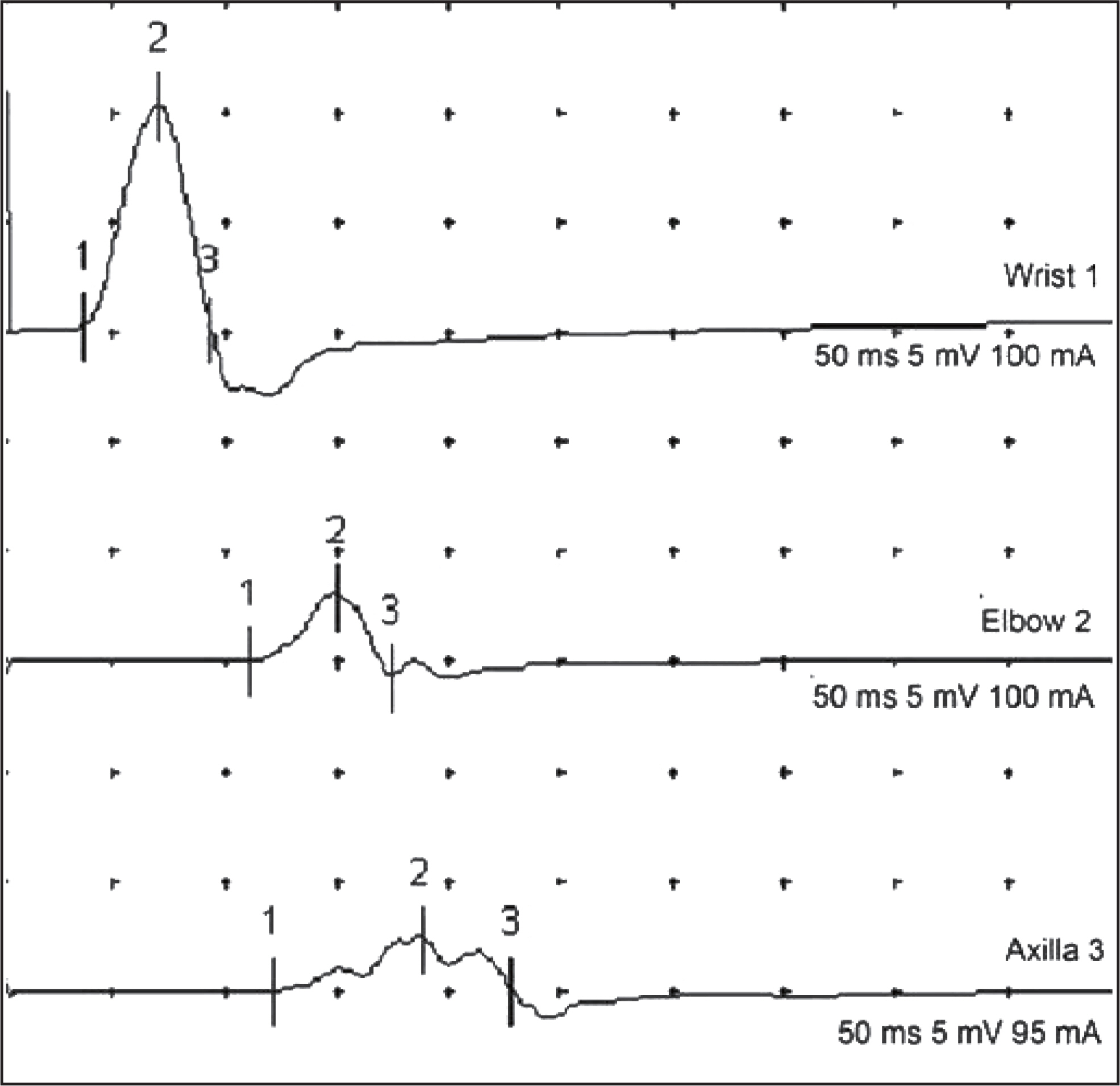Ann Clin Neurophysiol.
2018 Jul;20(2):71-78. 10.14253/acn.2018.20.2.71.
Nerve conduction studies: basic principal and clinical usefulness
- Affiliations
-
- 1Department of Neurology, Chung-Ang University Hospital, Chung-Ang University College of Medicine, Seoul, Korea.
- 2Department of Neurology, Seoul Paik Hospital, Inje University College of Medicine, Seoul, Korea.
- 3Department of Neurology, Seoul Medical Center, Seoul, Korea.
- 4Department of Neurology, Soonchunhyang University Hospital Cheonan, Soonchunhyang University College of Medicine, Cheonan, Korea.
- 5Department of Neurology, Asan Medical Center, University of Ulsan College of Medicine, Seoul, Korea.
- 6Department of Neurology, Hallym University Dongtan Sacred Heart Hospital, Hallym University College of Medicine, Hwaseong, Korea.
- 7Department of Neurology, Mokdong Hospital, Ewha Womans University School of Medicine, Seoul, Korea.
- 8Department of Neurology, Kangbuk Samsung Hospital, Sungkyunkwan University School of Medicine, Seoul, Korea.
- KMID: 2454708
- DOI: http://doi.org/10.14253/acn.2018.20.2.71
Abstract
- Nerve conduction study (NCS) is an electrophysiological tool to assess the overall function of cranial and peripheral nervous system, therefore NCS has been diagnostically helpful in the identification and characterization of disorders involving nerve roots, peripheral nerves, muscle and neuromuscular junction, and are frequently accompanied by a needle Electromyography. Furthermore, NCS could provide valuable quantitative and qualitative results into neuromuscular function. Usually, motor, sensory, or mixed nerve studies can be performed with using NCS, stimulating the nerves with the recording electrodes placed over a distal muscle, a cutaneous sensory nerve, or the entire mixed nerve, respectively. And these findings of motor, sensory, and mixed nerve studies often show different and distinct patterns of specific abnormalities indicating the neuromuscular disorders. The purpose of this special article is to review the neurophysiologic usefulness of NCS, to outline the technical factors associated with the performance of NCS, and to demonstrate characteristic NCS changes in the setting of various neuromuscular conditions.
MeSH Terms
Figure
Reference
-
References
1. Dumitru D, Amato A, Zwart M. Electrodiagnostic medicine. 2nd Ed.Philadelphia: Hanley & Belfus;2002. p. 191–208.2. Barry DT. AAEM minimonograph #36: basic concepts of electric-ity and electronics in clinical electromyography. Muscle Nerve. 1991; 14:937–946.
Article3. Binnie C, Cooper R, Mauguière F, Fowler C, Prior P. Clinical neurophysiology Vol 1 & 2. Oxford: Butterworth-Heinemann;2004.4. Delisa JA, Lee HJ, Baran EM, Lai KS. Manual of nerve conduction velocity and clinical neurophysiology. 3rd Ed.Baltimore: Raven Press;1994.5. Dorfman LJ. The distribution of conduction velocities (DCV) in peripheral nerves: a review. Muscle Nerve. 1984; 7:2–11.
Article6. Donofrio PD, Albers JW. AAEM minimonograph #34: polyneuropathy: classification by nerve conduction studies and electromyography. Muscle Nerve. 1990; 13:889–903.
Article7. Kimura J. Facts, fallacies, and fancies of nerve conduction studies: twenty-first annual Edward H. Lambert Lecture. Muscle Nerve. 1997; 20:777–787.
Article8. Brown WF. The physiological and technical basis of electromyography. Boston: Butterworth-Heinemann;1984. p. 95–168.9. Mallik A, Weir AI. Nerve conduction studies: essentials and pitfalls in practice. J Neurol Neurosurg Psychiatry. 2005; 76(Suppl 2):ii23–ii31.
Article10. Oh SJ. Principles of clinical electromyography case studies. 1st Ed.Baltimore: Lippincott Williams & Wilkins;1998. p. 78–120.11. Zwarts MJ, Guecher A. The relation between conduction velocity and axonal length. Muscle Nerve. 1995; 18:1244–1249.
Article
- Full Text Links
- Actions
-
Cited
- CITED
-
- Close
- Share
- Similar articles
-
- Nerve Conduction studies of Sunacute combined Degeneration
- Conduction Studies of the Saphenous Nerve in Normal Subjects and Patients with Femoral Neuropathy
- Nerve Conduction Studies after Surgical Release of Carpal Tunnel Syndrome
- Effects of Age, Sex and Height on Nerve Conduction Studies
- Segmental Ulnar Nerve Conduction Studies According to Elbow Position in Normal Subjects



